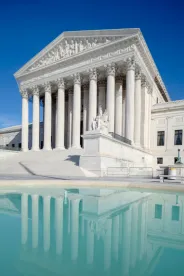The Supreme Court recently decided TC Heartland v. Kraft Food Group, 581 U. S. ____ (2017), which has changed the rules concerning where patent infringement lawsuits may be brought. Specifically, patent infringement actions against domestic corporations1 may now only be brought in states where an alleged infringer is incorporated, or in districts where an alleged infringer has a “regular and established place of business.” This holding may make it more expensive to pursue actions for patent infringement, and will significantly reduce forum shopping.
Before TC Heartland, the phrase “judicial district where the defendant resides” was extended to allow a patent infringement suit to be brought in any venue in which the defendant regularly sold the allegedly infringing product. See VE Holding Corp. v. Johnson Gas Appliance Co., 917 F.2d 1574 (Fed. Cir. 1990); Beverly Hills Fan Company v. Royal Sovereign Corp., 21 F.3d 1558 (Fed. Cir. 1994). Because goods are typically sold nationwide, patent owners wishing to bring a lawsuit often had the choice of any federal district court in the nation. This led to the majority of patent infringement suits being brought in only a handful of districts around the country that were generally perceived to be friendly to the patent owner, e.g., Eastern District of Texas, Northern District of California, etc. As a result, these districts and judges became accustomed to dealing with patent infringement cases, which arguably has led to more predictable outcomes. Forum shopping became typical; patent owners and potential defendants would often race to the district which suited each best in order to be the first to file their action (often determining where the action would be heard).
In TC Heartland, the Supreme Court was called upon to interpret 28 U.S.C. §1400(b), which states that a civil action for patent infringement may be brought in either “the judicial district where the defendant resides, or where the defendant has committed acts of infringement and has a regular and established place of business.” The Court unanimously decided that the word “resides” is limited to the alleged infringer’s state of incorporation.
The Effects of TC Heartland: The Return of “Regular and Established Place of Business”
As a result of the Court’s ruling, a plaintiff wishing to bring a patent infringement suit relying on the first part of §1400(b), only “where the defendant resides,” will have the option to file a lawsuit in the state in which the alleged infringer is incorporated. Yet a patent holder will have the additional option to file based on the second part of §1400(b), which allows for filing in districts in which the “defendant has committed acts of infringement and has a regular and established place of business.” As such, the following district court decisions may be helpful in construing the phrase “a regular and established place of business.”
Of particular interest is the recent district court decision in Raytheon Company v. Cray, Inc., in which Judge Gilstrap of the Eastern District of Texas used a four factor approach to determine what constitutes a “regular and established place of business.” 2-15-cv-01554 (E.D. Texas June 29, 2017). The factors considered by the Court included (1) whether the defendant has a physical presence in the district (such as “property, inventory, infrastructure, or people”), (2) whether the defendant represents that it has a presence in the district, (3) whether defendant derives benefits from its presence in the district (such as sales revenue), and (4) whether “defendant interacts in a targeted way with existing or potential customers, consumers, users, or entities within a district” (such as “localized customer support, ongoing contractual relationships, or targeted marketing efforts”). Id. In Raytheon, the Court determined that the defendant did have a regular and established place of business in the district because the defendant’s single sales representative had been working for the defendant within the district for seven years at the time the suit was filed. Id. The defendant paid the sales representative a salary, gave the sales representative administrative support from another district, and gave the sales representative reimbursement for business cell phone use, internet fees, business mileage, and other costs for business travel, which allowed the representative to “sell products to customers using an ‘office’ telephone number with a [district] area code.” Id.
Other cases give further insight into how courts will now interpret this second filing option under §1400(b):
Actions in State were Enough to Show a “Regular and Established Place of Business”
-
Renting space to accommodate ten full time salespersons was enough to establish a regular and established place of business within the district. Clopay v. Newell Co., Inc., 527 F. Supp. 733, 740 (D.Del. 1981).
-
The fact that defendant’s employees are in the district, and that “they own or rent homes here, and they essentially work out of their homes” was enough to establish a regular and established place of business. Brunswick Corp. v. Suzuki Motor Co., 575 F. Supp. 1412, 1424 (E.D. Wis. 1983).
Actions in State were not Enough to Show a “Regular and Established Place of Business”
-
Being “authorized to do business” in the state, having a “website allowing viewers to access a list of” distributors in the district, and selling activity trackers to distributors in the district were all not enough to establish a “regular and established place of business” in the district. LoganTree v. Garmin International, Inc., 5-17-cv-00098 (W. D. Texas 2017).
-
“The fact that defendants may communicate by email or telephone with customers in [this district] or ship product from [another district] to customers in this district does not establish that defendants have a permanent and continuous presence here. . . . Likewise, the allegation that defendants ‘may have physically visited ... or otherwise been in this district for business’ is not sufficient because even if true, such visits do not establish a permanent and continuous presence.” Stuebing Automatic Machine Company v. Gavronsky, 1-16-cv-00576 (S.D. Ohio 2017).
-
Employing only one sales engineer in the district where all sales orders are sent to, approved, and shipped from another district is not enough to show a regular and established place of business. O. Smith-Inland, Inc. v. Hoeganaes Corp., 407 F. Supp. 539, 542 (N.D. Ill. 1976).
-
Maintaining two salesmen in the district, both salaried and given automobiles by the company and where “[a]ll orders solicited by both salesmen are forwarded to the Division's district office in [another district]” and the division within the district maintained “no bank accounts, files, inventory, or other salaried personnel in the” district was not enough to give the defendant a regular and established place of business in the district. Gaddis v. Calgon Corp., 325 F. Supp. 16, 17 (N.D. Tex. 1971).
-
“[T]he mere presence of defendant's salesmen within this district does not constitute a regular and established place of business because they do not represent a significant ongoing corporate presence.” Silicon Tech., Inc. v. United Refractories, Inc., 632 F. Supp. 1, 2 (W.D. Pa. 1985).
-
The fact that the “defendant has only one operation of a business nature in the District, described as a ‘Repair and Rebuild Shop,’ on a plot of ground approximately 139 feet by 30 feet…but has no warehouse or sales room there and does not solicit or accept orders for mining equipment thereat” was not enough to give the defendant a “regular and established place of business.” Jeffrey Galion, Inc. v. Joy Mfg. Co., 323 F. Supp. 261, 265 (N.D. W. Va. 1971).
-
Having an office in the district that “operates primarily as a mail drop” with future plans to expand the role of the” office was not enough to establish a regular and established place of business and that the defendant also did not commit acts of infringement in the district because it did “not operate any customer computers in New Jersey; nor did it maintain any hardware there.” Magicorp v. Kinetic Presentations, Inc., 718 F. Supp. 334, 345 (D.N.J. 1989).
-
Having “two engineers…employed…to solicit business” but not accepting or rejecting any orders in the district, but rather transmitting them to another district “for approval and shipment” was not enough to show a regular and established place of business. Morse v. Master Specialties Co., 239 F. Supp. 641, 642 (D.N.J. 1964).
Actions in State were Enough to Show that “Defendant has Committed Acts of Infringement” in the Jurisdiction
-
“[A]ctively inducing others to infringe a patent is therefore an act of infringement contemplated by Section 1400(b)…the assistance provided by the 'sales engineers' of the defendant in soliciting sales of the accused devices in this district; the availability of…an employee of the defendant, to repair accused devices in this judicial district, which on at least one occasion he and another employee so did; and, the physical exhibition on at least one occasion of one of the accused devices at a trade show in this judicial district” support that sufficient acts of infringement were committed in the district. Dover Corp. v. Fisher Governor Co., 221 F. Supp. 716, 719 (S.D. Tex. 1963).
These cases suggest that having a larger number of employees permanently carrying out their business employment tasks in the district will more likely constitute a “regular and established place of business.” On the contrary, having a smaller number of sales persons taking orders to be sent to another district for approval and implementation may not constitute a “regular and established place of business.” Further, in addition to some of the above cases, the location of infringing acts may be advised by decisions involving territoriality issues.
The holding in TC Heartland will likely benefit defendants in patent infringement cases while making enforcement of patent rights more difficult for potential plaintiffs. For example, a plaintiff wishing to sue multiple parties for infringement of one patent may now have to maintain multiple suits in multiple courts across the country, whereas previously they may have been able to consolidate all causes of action into one suit if all of the defendants had sold products in at least one common state. This could lead to inconsistent results where the same patents are at issue in different courts. Multidistrict Litigation (MDL) processes may now be needed to assist when these types of issues arise. Further, judges that have never tried a patent case (or have limited experience in patent cases) are now more likely to hear such cases, which at least initially may result in less predictable outcomes that are more expensive to obtain.
1. The Court notes that this holding does not affect patent suits against foreign corporations or the Court’s holding in Brunette Machine Works, Ltd. v. Kockum Industries, Inc., 406 U. S. 706 (1972) (holding that foreign corporations may be sued for patent infringement in any district under 28 U. S. C. § 1391 (d), and that § 1400 (b) does not overrule this).





 />i
/>i
